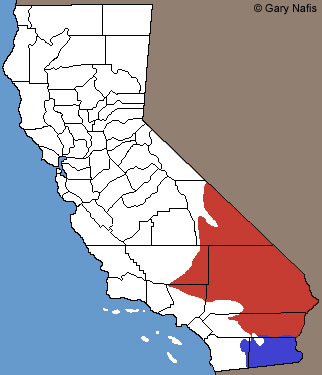|
 |
| Adult, Inyo County |
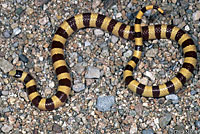 |
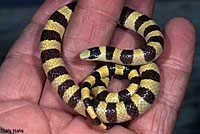 |
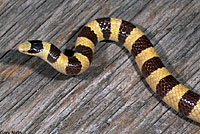 |
| Adult, Kern County |
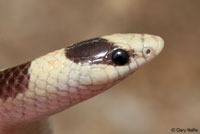 |
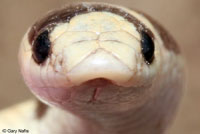 |
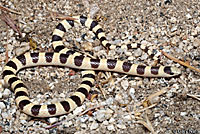 |
| |
Adult, Riverside County |
|
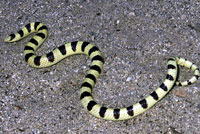 |
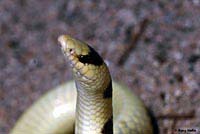 |
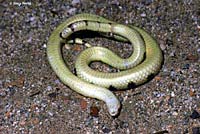 |
| |
Adult, Riverside County |
|
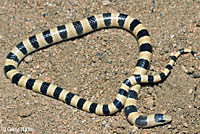 |
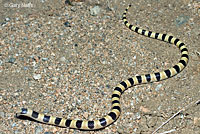 |
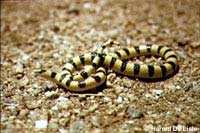 |
| Adult, Inyo County |
Adult, Riverside County
© Harold De Lisle |
|
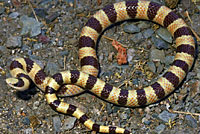 |
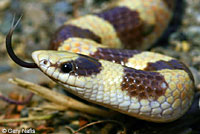 |
| Adult, northeast Kern County |
 |
 |
Adult male, San Bernardino County
© Trevor Yehle |
Adult, Kern County © Ryan Sikola |
 |
 |
Adult, Riverside County
© Gregory Litiatco |
Adult, Riverside County © Grigory Heaton |
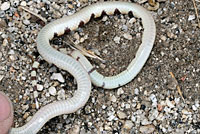 |
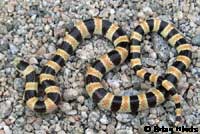 |
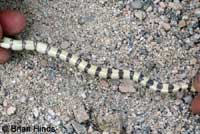 |
| Adult, northeast Kern County |
Adult, northern Riverside County © Brian Hinds
This snake from the Little San Bernardino Mountains, which are in the range of
C. occipitalis, shows characteristics of the southern species of Chionactis -
C. a. annulata - including some red markings and dark bands that circle the body. (Most of the dark bands on C. occipitalis do not circle the body.)
|
| |
Mohave Shovel-nosed Snakes Formerly recognized as the subspecies
Chionactis occipitalis talpina - Nevada Shovel-nosed Snake |
 |
| Adult, Inyo County |
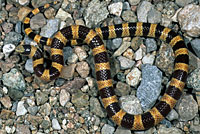 |
 |
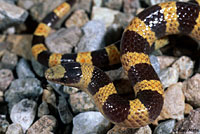 |
| Adult, Inyo County (formerly Chionactis occipitalis talpina) |
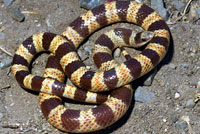 |
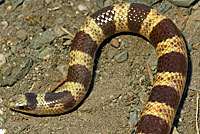 |
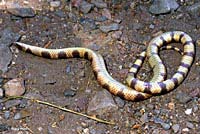 |
Adult, Inyo County (formerly Chionactis occipitalis talpina)
|
 |
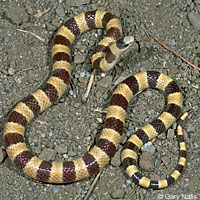 |
|
| Adult, Inyo County (formerly Chionactis occipitalis talpina) |
|
| |
| Mohave Shovel-nosed Snakes with Atypical Coloring |
 |
| Dark adult with no yellow or red coloring, San Bernardino County, from dark lava field habitat © Ryan Sikola |
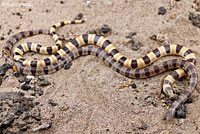 |
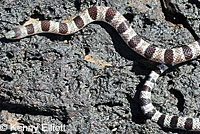 |
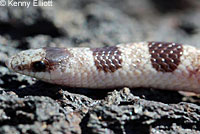 |
Top: a typically-colored adult
Bottom: the same dark adult seen above. Both were found at the same San Bernardino lava field location © Ryan Sikola |
© Kenny Elliott This typically colorless snake was observed in a black lava field in San Bernardino County. Some snakes and lizards in areas with dark lava have developed dark coloring to better blend in with the environment, but this snake is partly white, so I suspect it is missing the red and yellow pigments normally found on this species. |
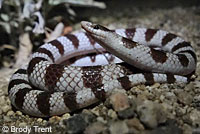 |
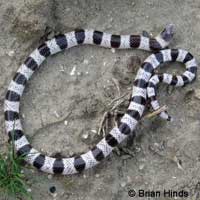 |
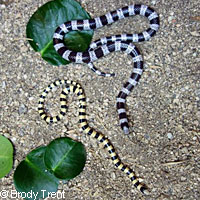 |
Anerythristic adult, Riverside County
© Brody Trent
|
This black and white shovel-nosed snake was found in Riverside County
© Brian Hinds |
Top: anerythristic adult
Bottom: normally-pigmented sub-adult
Riverside County © Brody Trent |
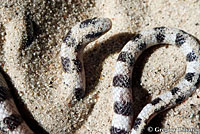 |
 |
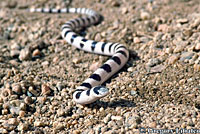 |
| Black and white phase adult from Riverside County © Gregory Litiatco |
| |
|
|
| Habitat |
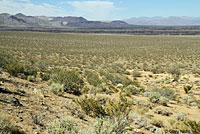 |
 |
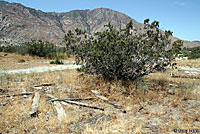 |
| Habitat, Inyo County |
Habitat, Inyo County |
Habitat, Riverside County |
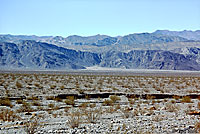 |
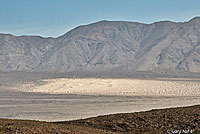 |
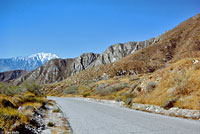 |
| Habitat, Inyo County |
Habitat, Inyo County |
Habitat, Riverside County |
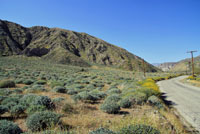 |
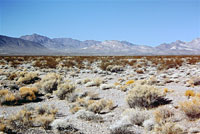 |
|
| Habitat, Riverside County |
Habitat, desert on the CA Border,
Nye County, Nevada
|
|
| |
|
|
| Short Videos |
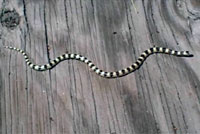 |
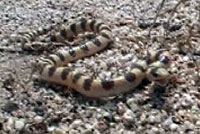 |
|
| Two views of a Mohave Shovel-nosed Snake crawling. |
Tired of being continually picked up and posed for the camera, this tiny but gutsy Mohave Shovel-nosed Snake finally got angry and struck repeatedly at the camera. |
|
| |
|
|
| Similar Snakes |
Comparison chart of Chionactis in California,
along with the similar sympatric species - Sonora semiannulata,
and the similar species - Chilomeniscus stramineus.
|
 |
 |
|
|
| Description |
Not Dangerous - This snake does not have venom that can cause death or serious illness or injury in most humans.
Commonly described as "harmless" or "not poisonous" to indicate that its bite is not dangerous, but "not venomous" is more accurate. (A poisonous snake can hurt you if you eat it. A venomous snake can hurt you if it bites you.)
|
| Size |
Adults are 11 - 17 inches long (25 - 43 cm)
|
| Appearance |
A small rounded snake with smooth, unkeeled, shiny scales.
The head is narrow with a large spade-like scale on the tip of a flat shovel-like snout, a countersunk lower jaw, and nasal valves. |
| Color and Pattern |
The ground color is cream or yellowish and the body is circled with 24 or more dark brown bands, usually with no red crossbands between them.
Most dark bands do not completely encircle the body.
|
| Life History and Behavior |
Activity |
Nocturnal.
Burrows underground in daytime, but occasionally found by day in shaded areas.
Smooth scales, flat shout, concave abdomen, and nasal valves are adaptations that allow for a quick swimming movement through loose sand, with an s-shaped, side-to-side movement.
Often seen crossing desert roads at night. |
| Diet and Feeding |
| Eats invertebrates: insects, scorpions, spiders, centipedes, larval insects and moths, often while the snake is burrowing. |
| Reproduction |
Females are oviparous, laying eggs late spring through summer.
|
| Habitat |
Inhabits dry desert habitats with loose sand and often with little vegetation - washes, dunes, sandy flats, rocky hillsides.
|
| Geographical Range |
The species Chionactis occipitalis - Western Shovel-nosed Snake, occurs from the Southern California deserts into Nevada, western Arizona, Baja California and northern Sonora, Mexico.
|
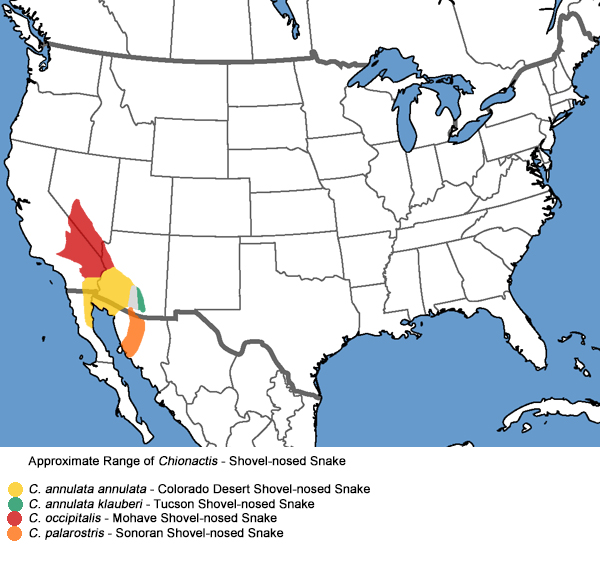 |
| Elevational Range |
Found to about 4,700 feet (1,430 m) in elevation. (Stebbins, 2003)
|
| Notes on Taxonomy |
Hansen and Shedd 2025 includes this taxonomic note: "Cox et al (2018) [shown directly below] recommended that the "groundsnakes" (inclusive of species of Chionactis and Sonora) be placed together in a single genus (Sonora). In the interest of stability, we follow the traditional arrangement in recognizing Chionactis and Sonora as distinct genera, pending further evaluation by the scientific community."
--------------------------------------------------------------------------------------------------------------------------------------------------------------------
Cox et al in their April 2018 paper "Synopsis and taxonomic revision of three genera in the snake tribe Sonorini," synonymized genera Chilomeniscus and Chionactis with genus Sonora. They did not discuss common names changes.
If their taxomomy is accepted:
* Sonora semiannulata semiannulata becomes Sonora semiannulata;
* Chionactis occipitalis becomes Sonora occipitalis;
* Chionactis annulata annulata becomes Sonora annulata;
* Chilomeniscus stramineus, where possibly present in California, becomes Sonora cincta.
(Synopsis and taxonomic revision of three genera in the snake tribe Sonorini.
Christian L. Cox, Alison R. Davis Rabosky, Iris A. Holmes, Jacobo Reyes-Valasco, Corey E. Roelke, Eric N. Smith, Oscar Flores-Villela, Jimmy A. GcGuire and Jonathan A. Campbell.
Journal of Natural History, 2018 Vol. 52, Nos. 13-16, 945-988.
https://doi.org/10.1080/00222933.2018.1449912)
--------------------------------------------------------------------------------------------------------------------------------------------------------------------SSAR Herpetological Circular No. 43, 2017, recommends a change in the currently accepted taxonomy of
Chionactis occipitalis:
"Wood et al. (2008, Conserv. Gen. 9: 1489–1507) demonstrated, using mtDNA and morphological data, that population structure was not concordant with the traditional subspecific taxonomy. They also revealed two potentially independent evolutionary lineages. A phylogeographic study from Wood et al. (2014; PLoS ONE e97494) using mtDNA and microsatellites indicates that C. o. annulata should be elevated to species status, while retaining two subspecies
C. a. annulata and C. a. klauberi, that conform to patterns of genetic structure. The authors found no support for
C. o. talpina and place it in synonomy with C. occipitalis."
C. o. annulata becomes: C. annulata annulata (Baird, 1859 “1858”) - Colorado Desert Shovel-nosed Snake
C. o. klauberi becomes: C. a. klauberi (Stickel, 1941) - Tucson Shovel-nosed Snake
C. o. occipitalis becomes: C. occipitalis (Hallowell, 1854) - Mohave Shovel-nosed Snake
C. o. talpina becomes: C. occipitalis (Hallowell, 1854) - Mohave Shovel-nosed Snake
--------------------------------------------------------------------------------------------------------------------------------------------------------------------
'The spelling of the word "Mojave" or "Mohave" has been a subject of debate. Lowe in the preface to his "Venomous Reptiles of Arizona" (1986) argued for "Mohave" as did Campbell and Lamar (2004, "The Venomous Reptiles of the Western Hemisphere"). According to linguistics experts on Native American languages, either spelling is correct, but using either the "j" or "h" is based on whether the word is used in a Spanish or English context. Given that this is an English names list, we use the "h" spelling (P. Munro, Linguistics, UCLA, pers. comm.).'
(Taxon Notes to Crotalus scutulatus, SSAR Herpetological Circular no 39, published August 2012, John J. Moriarty, Editor.)
--------------------------------------------------------------------------------------------------------------------------------------------------------------------
"Taxonomy follows Cox et al. (2018, Journal of Natural History 52: 945–988). Cox et al. (op. cit.) used mt- and nDNA data to produce a phylogeny in which Chilomeniscus and Chionactis are paraphyletic with respect to Sonora. Their phylogeny also recommends modification of species content through resurrection and elevation of several taxa: Sonora cincta, S. episcopa, S. taylori."
(Nicholson, K. E. (ed.). 2025 SSAR Scientific and Standard English Names List)
---------------------------------------------------------------------------------------------------------------------------------------------------------------------
Alternate and Previous Names (Synonyms)
Chionactis occipitalis - Mojave Shovel-nosed Snake (Hansen and Shedd 2025)
Sonora occipitalis (Cox et al 2018)
Chionactis occipitalis talpina - Nevada Shovel-nosed Snake (Stebbins 1954, 1966, 1985, 2003 -Stebbins & McGinnis 2012, 2018)
Chionactis ooccipitalis occipitalis - Mojave Shovel-nosed Snake (Stebbins 1954,1966, 1985, 2003 -Stebbins & McGinnis 2012, 2018)
Chionactis. occipitalis- Western Shovel-nosed Snake (Stebbins1954, 1966, 1985, 2003 -Stebbins & McGinnis 2012, 2018)
Chionactis. occipitalis occipitalis - Mojave ringed snake; banded (ground) snake; (bicolor) spade-nosed snake; desert (ground) snake; Hallowell's ground snake; Mojave desert shovel-nosed snake; pencil snake; ringed ground snake; shovel-nosed ground snake; tricolor ground snake (Wright & Wright 1957)
Sonora occipitalis - Desert Burrowing Snake (Rhinostoma occipitale; Lamprosoma annulatum; Lamprosoma occipitale;
Chionactis occipitalis; Chionactis occipitalis annulatus. Desert Snake; Mohave Ringed Snake) (Grinnell and Camp 1917)
Chionactis occipitalis - Desert burrowing snake (Camp 1916)
|
| Conservation Issues (Conservation Status) |
| None |
|
|
Taxonomy |
| Family |
Colubridae |
Colubrids |
Oppel, 1811 |
| Genus |
Chionactis |
Shovel-nosed Snakes |
Cope, 1860 |
| Species |
occipitalis |
Mohave Shovel-nosed Snake |
(Hallowell, 1854)
|
|
Original Description |
Chionactis occipitalis - (Hallowell, 1854) - Proc. Acad. Nat. Sci. Philadelphia, Vol. 7, p. 95
from Original Description Citations for the Reptiles and Amphibians of North America © Ellin Beltz
|
|
Meaning of the Scientific Name |
Chionactis - Greek - chion = snow + aktis = ray or beam
occipitalis - Latin = pertaining to the back of the head
from Scientific and Common Names of the Reptiles and Amphibians of North America - Explained © Ellin Beltz
|
|
Related or Similar California Snakes |
Chionactis annulata annulata - Colorado Desert Shovel-nosed Snake
Sonora semiannulata semiannulata - Variable Groundsnake
Rhinocheilus lecontei - Western Long-nosed Snake
|
|
More Information and References |
California Department of Fish and Wildlife
Hansen, Robert W. and Shedd, Jackson D. California Amphibians and Reptiles. (Princeton Field Guides.) Princeton University Press, 2025.
Stebbins, Robert C., and McGinnis, Samuel M. Field Guide to Amphibians and Reptiles of California: Revised Edition (California Natural History Guides) University of California Press, 2012.
Stebbins, Robert C. California Amphibians and Reptiles. The University of California Press, 1972.
Flaxington, William C. Amphibians and Reptiles of California: Field Observations, Distribution, and Natural History. Fieldnotes Press, Anaheim, California, 2021.
Nicholson, K. E. (ed.). 2025. Scientific and Standard English Names of Amphibians and Reptiles of North America North of Mexico, with Comments Regarding Confidence in Our Understanding. Ninth Edition. Society for the Study of Amphibians and Reptiles. [SSAR] 87pp.
Samuel M. McGinnis and Robert C. Stebbins. Peterson Field Guide to Western Reptiles & Amphibians. 4th Edition. Houghton Mifflin Harcourt Publishing Company, 2018.
Stebbins, Robert C. A Field Guide to Western Reptiles and Amphibians. 3rd Edition. Houghton Mifflin Company, 2003.
Behler, John L., and F. Wayne King. The Audubon Society Field Guide to North American Reptiles and Amphibians. Alfred A. Knopf, 1992.
Robert Powell, Roger Conant, and Joseph T. Collins. Peterson Field Guide to Reptiles and Amphibians of Eastern and Central North America. Fourth Edition. Houghton Mifflin Harcourt, 2016.
Powell, Robert., Joseph T. Collins, and Errol D. Hooper Jr. A Key to Amphibians and Reptiles of the Continental United States and Canada. The University Press of Kansas, 1998.
Bartlett, R. D. & Patricia P. Bartlett. Guide and Reference to the Snakes of Western North America (North of Mexico) and Hawaii. University Press of Florida, 2009.
Bartlett, R. D. & Alan Tennant. Snakes of North America - Western Region. Gulf Publishing Co., 2000.
Brown, Philip R. A Field Guide to Snakes of California. Gulf Publishing Co., 1997.
Ernst, Carl H., Evelyn M. Ernst, & Robert M. Corker. Snakes of the United States and Canada. Smithsonian Institution Press, 2003.
Taylor, Emily. California Snakes and How to Find Them. Heyday, Berkeley, California. 2024.
Wright, Albert Hazen & Anna Allen Wright. Handbook of Snakes of the United States and Canada. Cornell University Press, 1957.
Joseph Grinnell and Charles Lewis Camp. A Distributional List of the Amphibians and Reptiles of California. University of California Publications in Zoology Vol. 17, No. 10, pp. 127-208. July 11, 1917.
|
|
|
The following conservation status listings for this animal are taken from the July 2025 State of California Special Animals List and the July 2025 Federally Listed Endangered and Threatened Animals of California list (unless indicated otherwise below.) Both lists are produced by multiple agencies every year, and sometimes more than once per year, so the conservation status listing information found below might not be from the most recent lists, but they don't change a great deal from year to year.. To make sure you are seeing the most recent listings, go to this California Department of Fish and Wildlife web page where you can search for and download both lists:
https://www.wildlife.ca.gov/Data/CNDDB/Plants-and-Animals.
A detailed explanation of the meaning of the status listing symbols can be found at the beginning of the two lists. For quick reference, I have included them on my Special Status Information page.
If no status is listed here, the animal is not included on either list. This most likely indicates that there are no serious conservation concerns for the animal. To find out more about an animal's status you can also go to the NatureServe and IUCN websites to check their rankings.
Check the current California Department of Fish and Wildlife sport fishing regulations to find out if this animal can be legally pursued and handled or collected with possession of a current fishing license. You can also look at the summary of the sport fishing regulations as they apply only to reptiles and amphibians that has been made for this website.
This snake is not included on the Special Animals List, which indicates that there are no significant conservation concerns for it in California.
|
| Organization |
Status Listing |
Notes |
| NatureServe Global Ranking |
|
|
| NatureServe State Ranking |
|
|
| U.S. Endangered Species Act (ESA) |
None |
|
| California Endangered Species Act (CESA) |
None |
|
| California Department of Fish and Wildlife |
None |
|
| Bureau of Land Management |
None |
|
| USDA Forest Service |
None |
|
| IUCN |
|
|
|
|
